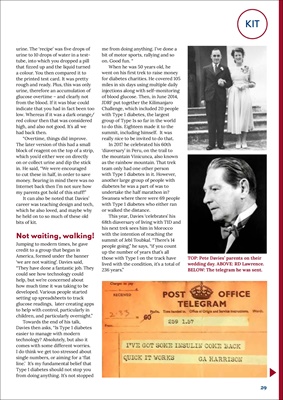
29
KIT
tube, into which you dropped a pill
that fizzed up and the liquid turned
a colour. You then compared it to
the printed test card. It was pretty
rough and ready. Plus, this was only
urine, therefore an accumulation of
glucose overtime - and clearly not
from the blood. If it was blue could
indicate that you had in fact been too
low. Whereas if it was a dark orange/
red colour then that was considered
high, and also not good. It's all we
had back then.
"Overtime, things did improve.
The later version of this had a small
block of reagent on the top of a strip,
which you'd either wee on directly
on or collect urine and dip the stick
in. He said, "We were encouraged
to cut these in half, in order to save
money. Bearing in mind there was no
Internet back then I'm not sure how
my parents got hold of this stuff!"
It can also be noted that Davies'
career was teaching design and tech,
which he also loved, and maybe why
he held on to so much of these old
bits of kit.
Not waiting, walking!
Jumping to modern times, he gave
credit to a group that began in
America, formed under the banner
'we are not waiting'. Davies said,
"They have done a fantastic job. They
could see how technology could
help, but we're concerned about
how much time it was taking to be
developed. Various people started
setting up spreadsheets to track
glucose readings, later creating apps
to help with control, particularly in
children, and particularly overnight."
Towards the end of his talk,
Davies then asks, "Is Type 1 diabetes
easier to manage with modern
technology? Absolutely, but also it
comes with some different worries.
I do think we get too stressed about
single numbers, or aiming for a 'flat
line.' It's my fundamental belief that
Type 1 diabetes should not stop you
from doing anything. It's not stopped
me from doing anything. I've done a
bit of motor sports, rallying and so
on. Good fun. "
When he was 50 years old, he
went on his first trek to raise money
for diabetes charities. He covered 105
miles in six days using multiple daily
injections along with self-monitoring
of blood glucose. Then, in June 2014,
JDRF put together the Kilimanjaro
Challenge, which included 20 people
with Type 1 diabetes, the largest
group of Type 1s so far in the world
to do this. Eighteen made it to the
summit, including himself. It was
really nice to be invited to do that.
In 2017 he celebrated his 60th
'diaversary' in Peru, on the trail to
the mountain Vinicunca, also known
as the rainbow mountain. That trek
team only had one other person
with Type 1 diabetes in it. However,
another large group of people with
diabetes he was a part of was to
undertake the half marathon in?
Swansea where there were 69 people
with Type 1 diabetes who either ran
or walked the distance.
This year, Davies 'celebrates' his
68th diaversary of living with T1D and
his next trek sees him in Morocco
with the intention of reaching the
summit of Jebl Toubkal. "There's 14
people going," he says, "if you count
up the number of years that's all
those with Type 1 on the track have
lived with the condition, it's a total of
236 years." TOP: Pete Davies' parents on their
wedding day. ABOVE: RD Lawrence.
BELOW: The telegram he was sent.